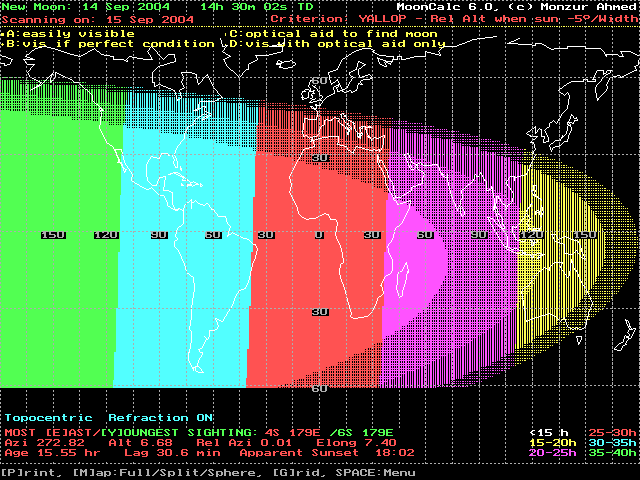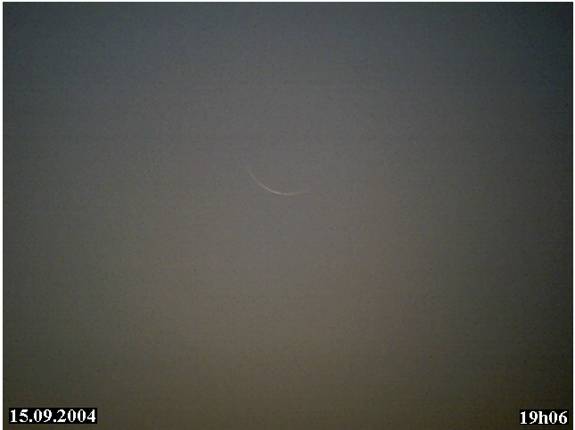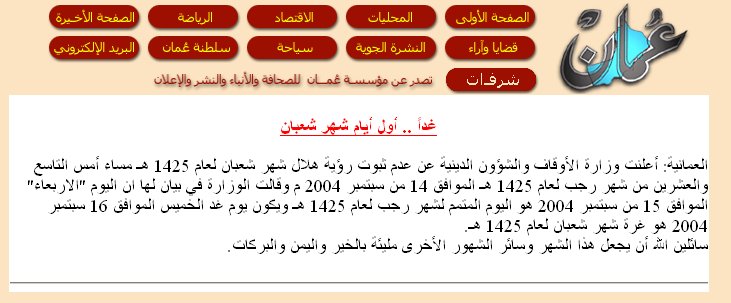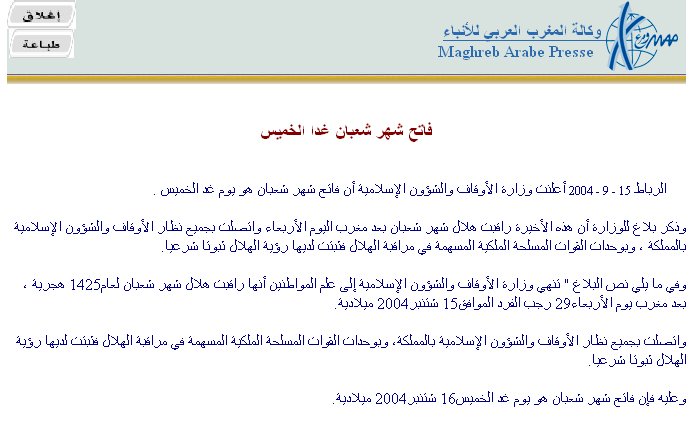
Visibility of Sha'ban Crescent
(1425 AH)

- When to Observe ?
- Observing the Waning Crescent of Rajab on Tuesday 14 September 2004
- Results of Observation
- Thursday is the first day of Shaban in Oman
- Thursday is the first day of Shaban in Morocco
- The First Day in Different Countries
- The Accuracy of The Astronomical Calculations.
- Related Links.
The geocentric new Moon will occur Inshalla on (Tuesday 14 September 2004), at
14:29 UT. On this day the program Moon
Calculator by Dr. Monzur Ahmed -according to Yallop criterion- showed that it is NOT possible to see the crescent from any where in the world
While on the next day (Wednesday 15 September 2004) the crescent should be visible by optical aid from Australia, south east Asia, Middle East, Southern Europe and northern parts of North America, and by naked eyes from India, Arabian peninsula, Africa, central and south parts of North America and South America.
According to the actual sighting of the crescent, the start of Sha'ban should be on
Thursday 16 September 2004 in all of the world.
- Results of seeing the crescent, and the first day of the month in different countries will be added here Inshalla as we receive the reports from ICOP's members. If you wish to be a member in ICOP, or to know more about it, kindly click here.
So far, the earliest sighting of the crescent was on Wednesday 15 September 2004 from Iran by Mr. Reza Amirzadeh and others.
Tuesday 14 September 2004:
Below is an official Omani statement which states that the crescent was not seen in Oman on Tuesday 14
September 2004, thus the beginning of Shaban will be on Thursday 16 September 2004.
Below is an official Moroccan statement which states that the crescent was seen in Morocco on Wednesday 15
September 2004, thus the beginning of Shaban will be on Thursday 16 September 2004.
Wednesday 15 September 2004 :-
Thursday 16 September 2004 : -
Friday 17 September 2004 : -
To know about the accuracy of the astronomical calculations, then please click here

When to Observe ?


Observing the Waning Crescent of Rajab on Tuesday 14 September 2004
Old Moon Crescent Observability
===============================
September 2004
Time from new at moonrise = 26 hours 25 minutes
Location = Tucson, Arizona (USA)
Longitude = 110.9645 W
Latitude = 32.4204 N
Elevation = 842 meters
Local moonrise at 5:05 a.m. (MST) 13 Sep. 2004
UT Time and Date of moonrise = 12:05 13 Sep. 2004
Crescent first observed through 5x25 binoculars:
Time = about 5:42 a.m. (MST) 12:42 (UT)
Altitude = 6 degrees
Azimuth = 80 degrees
Elongation of the Moon from Sun = 12.8 degrees
Percent of surface that was lit = 1.3 percent
Crescent first observed with the naked eye:
Time = about 5:42 a.m. (MST) 12:42 (UT)
Altitude = 6 degrees
Azimuth = 80 degrees
Elongation of the Moon from Sun = 12.8 degrees
Percent of surface that was lit = 1.3 percent
Final observation with naked eye:
Time = 5:50 a.m. (MST) 12:50 (UT)
Altitude = 7 degrees
Azimuth = 81 degrees
Final observation with 6 x 30 finder:
Time = 6:00 a.m. (MST)
Altitude = 10 degrees
Azimuth = 82 degrees
Final observation with telescope:
Time = 6:55 a.m. (MST) 13:55 (UT)
Altitude = 21 degrees
Azimuth = 90 degrees
Local sunrise at 6:07 a.m. (MST) 13 Sep. 2004
UT Time and Date of sunrise = 13:07 13 Sep. 2004
I kept the crescent in the C-8 easily while I viewed it continuously.
It was difficult to pick up, even though in the FOV if I left the
eyepiece for a few minutes, then returned. It was viewed at 6:55 a.m.,
but I couldn’t recover it from 7:03 to 7:19 a.m. I believe that if I
had stayed at the eyepiece, I could have followed the crescent into
(and maybe beyond) the 7:03 - 7:19 time range.
Wish us luck for sighting the Hilal tomorrow (Tuesday) evening (with
Dr. Polacheck.)
Old Crescent Moon & Mercury
Date: September 13, 2004
Location: West of Esfahan State (33:15N 50:05E)
Lens Focal Lenght: 48.5 mm
Shutter Speed: 1/2 sec
Aperture Value: F=2.4
Time: 06:13 a.m. LT (01:43 UT)
Camera: Digital Sony Camera F-717
Photographer: Alireza Mehrani


Results of Observation
Wednesday 15 September 2004 :


Thursday is the first day of Shaban in Oman


Thursday is the first day of Shaban in Morocco


The OFFICIAL First Day in Different Countries

The Accuracy of The Astronomical Calculations

Related Links





